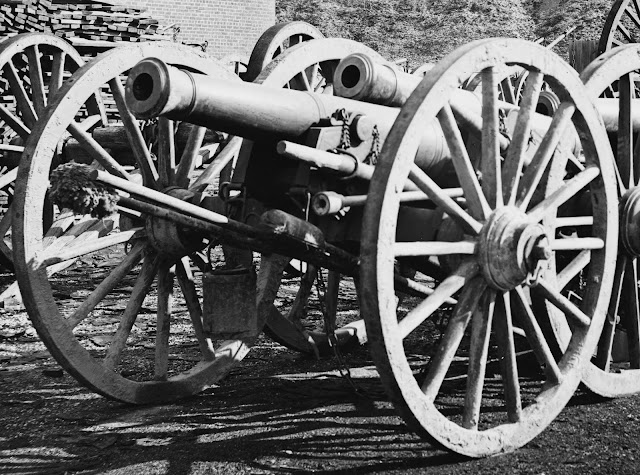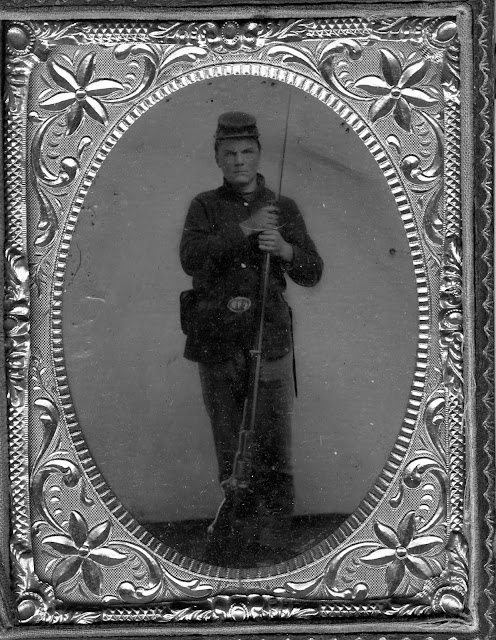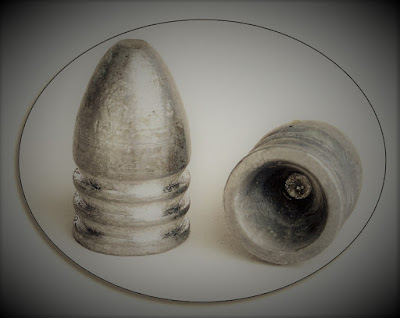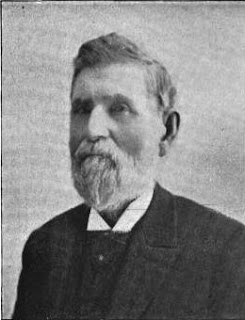Guns of Ivy Mountain
The little-remembered Battle of Ivy Mountain, Kentucky was known by several alternate names including the Battle of Dry Mountain. the Battle of Dry Creek, or the Battle of Piketon/Piketown/Pikeville. This small scale engagement was one of the earliest engagements in the Western Theater and pitted about 250 poorly-armed recruits of the 5th Kentucky (Confederate) Infantry against roughly 3,600 Federal troops led by bombastic Brigadier General William "Bull" Nelson. Located near present-day Ivel, Kentucky, the battle was fought along the state-owned river road which is today U.S. 23. A historic marker alongside the road commemorates the battle.
Fought on November 8, 1861 (one day after the Battle of Belmont several hundred miles to the west), the engagement began when the advance guard of Nelson's column unknowingly marched into an ambush set by Colonel John S. "Cerro Gordo" Williams' men at a bend of the river road near the confluence of Ivy Creek and the Levisa Fork of Big Sandy River a few miles northwest of Pikeville. Nelson's men fell back, brought forward their artillery, then deployed on Dry Mountain and drove back the Confederates. The Confederates, vastly outnumbered and lacking artillery, retreated after about an hour and a half and within a few days left Kentucky for the friendlier confines of Virginia. Nelson's victory was hailed in the North and initial reports grossly exaggerated the magnitude of the fight and the casualties; both sides lost a few dozen men killed and wounded. The true significance of Ivy Mountain was that it secured eastern Kentucky for the Union and was a boost to Northern morale.
Among the Federal troops who participated in the battle was Private Edward T. Pritchard of Battery D of the 1st Ohio Volunteer Light Artillery. Raised in northeastern Ohio and commanded by Captain Andrew J. Konkle (who previously served as captain of Co. K of the 19th Ohio during the three-months' service), the battery of four 6-pdr guns had mustered into service on November 1, 1861 and was immediately dispatched into Kentucky where it joined General Nelson's command at Prestonburg. The engagement at Ivy Mountain marked the first time the battery saw action during the Civil War. Pritchard's account was originally published in the November 30, 1861 issue of the Cleveland Morning Leader and I've supplemented his account with some quotations from a letter composed by two brothers, Henry and Jacob Baker, who also served in Battery D.
Camp Konkle, near Prestonburg, Kentucky,
November 8, 1861
Our bugler blew the assembly call at 3 o'clock this morning; all hands arose, the horses were fed and watered, and we moved from camp fully an hour before daylight. The column moved as follows: Colonel Marshall's Kentucky battalion [16th Kentucky] in advance, followed by the 2nd Ohio under the gallant Colonel [Len] Harris, the 21st Ohio under the brave little Colonel [Jesse] Norton, four pieces of cannon commanded by the 'pink-whiskered' Captain Konkle, followed by the 59th Ohio commanded by Colonel [James] Fyffe. The roads were miserable, being hardly four feet wide in some places; in fact, we were often compelled to unlimber our pieces and carry them along. One of our caissons went over the bank and lodged against a sycamore tree which prevented it from going into the river.
While Second Lieutenant [Henry C.] Lloyd was endeavoring to get it up the embankment, one of General Nelson's aides rode back and ordered the guns immediately forward as the advance guard was then skirmishing with the enemy's pickets two miles in advance. First Lieutenant [William H.] Pease with one gun went forward and Lieutenant [Lemuel P.] Porter soon followed with the other three. [The Baker brothers reported that "General Nelson failed to send out scouts and the enemy set a trap for us which we soon fell into. They had taken a position on both sides of what is called the narrows, their fortifications being of solid rock. The pass through which we had to go was only from six to ten feet wide and when we had got nicely into it, they commenced firing on us. We looked all around and not a single man could be seen but the bullets whizzed around our heads like ten thousand flies. Captain Konkle said we were in a hell of a place and so thought the rest of us."]
Shortly after this, Colonel Fyffe of the 59th Ohio rode up and ordered his regiment forward and informed Lieutenant Lloyd and myself that the enemy was pouring a deadly fire into our ranks. I advanced with the 59th and reached the battleground in the heat of the contests and hitching my horse to the fence, I walked up to where the guns were posted. [The Baker brothers continue: "We could not back out on account of the narrow road and it was about 15 minutes before we could get elevation sufficient to do anything. The infantry retreating back and taking the hill, Captain Konkle told us to put a few shells into a ledge of rocks which we instantly did. Then we got the first sight of their men. They scattered from there in a hurry but we were receiving heavy volleys from each side and soon two pieces were disabled."]
During the progress of the fight, the Kentucky Rebels were loudly singing "Dixie", huzzahing for Jeff Davis, and with intense vehemence cursing the Yankees who were invading their state. The scene in the narrows during the fight was awful. The dead men filled the road in heaps and the wounded screamed terrifically. The blood of the killed and wounded ran in stream into the river, and in the panic and fright, many of the Yankees were crowded off the perpendicular bank and fell into the water. ~J.P. Richards and H.F. Grimes, Confederate soldiers
The enemy had attacked us as we moved around the point of the mountain upon a narrow road, on the right of which lay the river and on the left a steep mountain studded with rocks which the boys could not ascend without going back some distance. Several hundred Rebels were stationed on the opposite side of the river in a cornfield, therefore our brave boys were subjected to a murderous fire from the rear as well as the front. Nevertheless, they stood their ground and fought nobly. Colonels Harris, Norton, and Fyffe remained at the head of their respective regiments calmly giving their orders. Ohio may well be proud of such men.
Our battery fired 60 shells nearly all of them taking effect. General Bull Nelson sighted the first gun but missed the mark. Then turning to Lieutenant Porter, he ordered him to throw a shell among a clump of spruce pines where there were from 30-40 of the enemy in ambush. "Aye, aye," said Porter. Pop went the gun and the shell exploded directly in the desired spot, killing several instantly and causing the rest to run for their lives. One of the number killed had his head and shoulders completely severed from his body. Captain Konkle considers it one of the best shots he ever saw made. General Nelson complimented the artillery highly.
 |
| Corporal John B. DeShong Battery D Later in 2nd US CT Heavy Artillery |
The battle lasted one hour and 50 minutes. The enemy was about 1,000 strong [actually roughly 250], part of them armed with Minie rifles. John S. Williams, the commander of the forces in this portion of the state, had gone on to Pikeville but a few hours previous to the battle leaving Henry M. Rust, a prominent lawyer and formerly a state senator from Greenupsburg in command. Rust received six wounds and was taken prisoner; he survived several hours after he was brought in from the battlefield. As near as I can ascertain up to the present time, our loss is five killed and 20 wounded. The enemy's loss is 60 killed and 15 wounded.
Only one of Konkle's men was wounded during the battle: Charles Curtiss, son of Curtiss of the firm of Smith & Curtiss, coffee and spice mills of Cleveland. He received a wound in the back while in the act of passing a shell from the limber to the gun. He is receiving the best of care and attention and we hope soon to have him back in our ranks. Poor Curtiss was a favorite with the members of the battery and his absence and wound are regretted by all. [Curtiss would be discharged for the wound in June 1862.] Captain Alexander S. Berryhill of Co. A of the 2nd Ohio was foremost in the battle and received a severe wound in the arm. [Berryville would be killed in action eleven months later to the day at Perryville.]
Sources:
Letter from Private Edward T. Pritchard, Battery D, 1st Ohio Volunteer Light Artillery, Cleveland Morning Leader (Ohio), November 30, 1861, pg. 3
Letters from Privates Henry A. and Jacob L. Baker, Battery D, 1st Ohio Volunteer Light Artillery, Summit County Beacon (Ohio), December 5, 1861, pg. 3











This comment has been removed by the author.
ReplyDelete